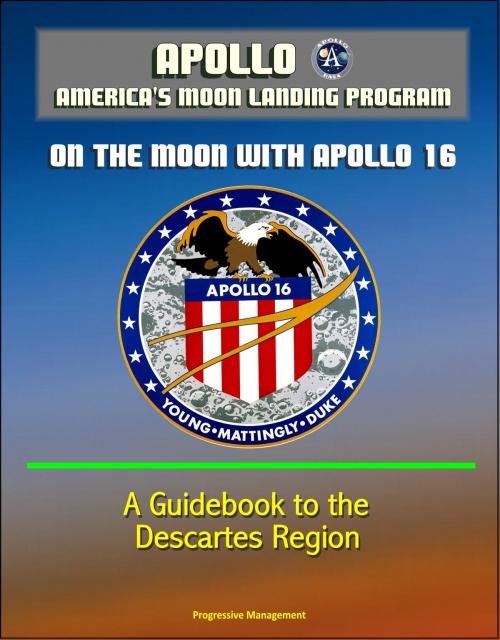Apollo and America's Moon Landing Program: On The Moon With Apollo 16 - A Guidebook to the Descartes Region
Nonfiction, Science & Nature, Technology, Aeronautics & Astronautics, Science, Physics, Astrophysics & Space Science| Author: | Progressive Management | ISBN: | 9781311742100 |
| Publisher: | Progressive Management | Publication: | September 7, 2014 |
| Imprint: | Smashwords Edition | Language: | English |
| Author: | Progressive Management |
| ISBN: | 9781311742100 |
| Publisher: | Progressive Management |
| Publication: | September 7, 2014 |
| Imprint: | Smashwords Edition |
| Language: | English |
This is the second in a series of three pre-flight guidebooks to Apollo lunar landing missions written for the public. (Similar books were made for Apollo 15 and Apollo 17.) Published by NASA just prior to the launch of Apollo 16, it contains extensive information on the planned rover traverses and science experiments conducted by astronauts Young, Duke, and Mattingly in 1972. Author Gene Simmons, the chief scientist at the Manned Spacecraft Center in Houston, wrote the following about the book, and captures some of the anticipatory excitement in the days before the historic mission:
"Excellent commentaries have been available over television for each previous Apollo mission. However, because of the increased complexity of the surface operations beginning with Apollo 15 and especially because of the greater amount of time devoted to science-activities, I believe that a written guide would be welcomed by the interested viewer of Apollo 16. The material in this guidebook is intended to be used in conjunction with the other material shown over television.
The science-activities of the astronauts on the surface are divided between "experiments" and "traverses." For the experiments, the astronauts set up equipment on the Moon that collects data and (generally) transmits the data back to Earth. These experiments are described briefly in the section "Lunar Surface Scientific Experiments and Hardware." The reader need not read about all the details of each experiment on first reading. Quite frankly, even I find that section is rather lengthy although complete, but I have chosen to keep it in the present form so that you may refer to the individual experiments as you wish. I do recommend scanning this section before the first Extra Vehicular Activity (EVA) in order to understand something about each of the experiments.
Most of the astronauts' time on the lunar surface will be spent on the traverses along which they describe the geologic features of the landing site, collect rocks, shoot pictures, drive core tubes, and so on. The section "Traverse Descriptions" is a guide to those activities. It tells in general terms the things the astronauts will do on each traverse. It should be used in the same way that a flexible itinerary for a vacation trip through New England would be used. Refer to it during the traverse. But do not try to read it in great detail before the traverse.
The section "Lunar Geology Experiment" should be read before the traverses begin. There you will find descriptions of the tools that are used, the various kinds of photographs taken, and so on.
An important part of this guidebook is concerned with "orbital science." By orbital science, I mean those science activities done in space rather than on the lunar surface. The orbital experiments will probably not be covered extensively on television. But the data obtained on the last mission, Apollo 15, are so exciting that I think you may wish to know what is being done on Apollo 16. A general discussion of the scientific work to be done is given in the section "Introduction to Orbital Science." And then in the section "Orbital Science Activities," you will find the experiments and their objectives described. You may not wish to read these sections through at one sitting. Rather, I have included them chiefly for your reference when needed."
This is the second in a series of three pre-flight guidebooks to Apollo lunar landing missions written for the public. (Similar books were made for Apollo 15 and Apollo 17.) Published by NASA just prior to the launch of Apollo 16, it contains extensive information on the planned rover traverses and science experiments conducted by astronauts Young, Duke, and Mattingly in 1972. Author Gene Simmons, the chief scientist at the Manned Spacecraft Center in Houston, wrote the following about the book, and captures some of the anticipatory excitement in the days before the historic mission:
"Excellent commentaries have been available over television for each previous Apollo mission. However, because of the increased complexity of the surface operations beginning with Apollo 15 and especially because of the greater amount of time devoted to science-activities, I believe that a written guide would be welcomed by the interested viewer of Apollo 16. The material in this guidebook is intended to be used in conjunction with the other material shown over television.
The science-activities of the astronauts on the surface are divided between "experiments" and "traverses." For the experiments, the astronauts set up equipment on the Moon that collects data and (generally) transmits the data back to Earth. These experiments are described briefly in the section "Lunar Surface Scientific Experiments and Hardware." The reader need not read about all the details of each experiment on first reading. Quite frankly, even I find that section is rather lengthy although complete, but I have chosen to keep it in the present form so that you may refer to the individual experiments as you wish. I do recommend scanning this section before the first Extra Vehicular Activity (EVA) in order to understand something about each of the experiments.
Most of the astronauts' time on the lunar surface will be spent on the traverses along which they describe the geologic features of the landing site, collect rocks, shoot pictures, drive core tubes, and so on. The section "Traverse Descriptions" is a guide to those activities. It tells in general terms the things the astronauts will do on each traverse. It should be used in the same way that a flexible itinerary for a vacation trip through New England would be used. Refer to it during the traverse. But do not try to read it in great detail before the traverse.
The section "Lunar Geology Experiment" should be read before the traverses begin. There you will find descriptions of the tools that are used, the various kinds of photographs taken, and so on.
An important part of this guidebook is concerned with "orbital science." By orbital science, I mean those science activities done in space rather than on the lunar surface. The orbital experiments will probably not be covered extensively on television. But the data obtained on the last mission, Apollo 15, are so exciting that I think you may wish to know what is being done on Apollo 16. A general discussion of the scientific work to be done is given in the section "Introduction to Orbital Science." And then in the section "Orbital Science Activities," you will find the experiments and their objectives described. You may not wish to read these sections through at one sitting. Rather, I have included them chiefly for your reference when needed."















